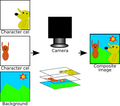Traditional animation facts for kids
Traditional animation is much harder than today's style of animation. It often uses a stop-motion camera to "liven", or animate, the photos made by the producer. When movie-makers use stop-motion, they need to draw one picture for every scene. However, there are tools to help save time with movie-making. Other types of animation, such as limited or digital animation, can also be used now. FPS is the number of times a movie is shot in one second.
Contents
Process
Filming
The photographer first shoots out or edits many photos. These photos are combined to make the storyline. And as with all movies, not all scenes make it into the final movie.
Editing
Many people help out in the editing of a movie. But in old times, people had to draw the scenes on their own. Then the stop-motion camera took a photo of a scene once a second.
Involvement
Most movies or cartoons in the 1950's required very hard work of the editors. To make things cheaper, though, people made limited animation that used two to three copies of the same image (so the stop-motion process would be two to three times faster.)
Current
Right now movie-makers use digital animation to "liven the movie even more". Movies from the 2000 to 2010 years are usually 1–2 hours long.
Common units
FPS
FPS, or frames per second, is the number of scenes being shot in one second. The higher this is, the more "smooth" the film looks. Most movies have an FPS of 24 to 60.
Tools
Cels
Cels, or celluloids, are tools used to "preserve" scenes. An editor uses a cell to draw a scene then make changes to it on the next drawing. It is useful when a cartoon or movie involves moving figures or objects.
Sketcher
Sometimes a sketch pad is used to draft the scenes the editors think would be good in the movie. A sketchpad at first may contain a comic book that looks like an animation when the editors flip it back and forth.
Live video shower
Often editors preview the animation with a video shower. On the stream of scenes, movie-makers test their animation and fix bugs or problems.
Related pages
Images for kids
-
Painting with acrylic paint on the reverse side of an already inked cel.
-
A horse animated by rotoscoping from Eadweard Muybridge's 19th-century photos. The animation consists of 8 drawings which are "looped", i.e. repeated over and over. This example is also "shot on twos", i.e. shown at 12 drawings per second.




